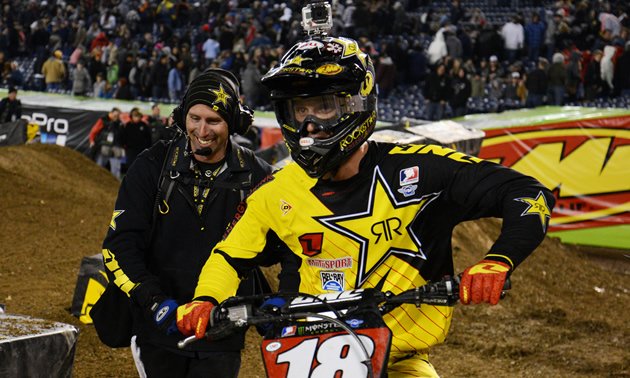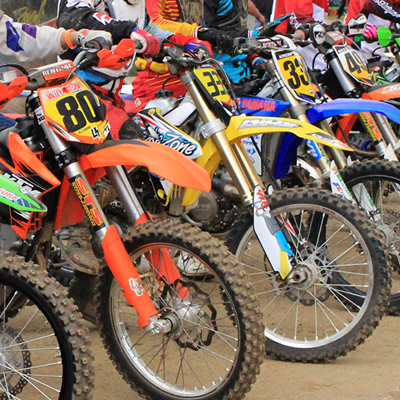In the olden days, when the sport was dominated by Europeans, it was Roger DeCoster. “The Man,” as he was called, won five world championships. Then the Americans caught on. First, it was Bob “Hurricane” Hannah who was nearly invincible, then Ricky Johnson and then it was “The King” of Supercross, Jeremy McGrath—whose 72 wins still top the charts. Finally, McGrath was beaten by a young punk named Ricky Carmichael who went on to earn the nickname “The Goat,” which, for the uninitiated, stands for “The Greatest Of All Time.”
With all these riders you could pretty much say, “They never lost a race—they just ran out of time!” In each case, as the rider’s fame grew, the excitement at the races diminished. If Carmichael, or any of the aforementioned great ones, got a top 10 start you pretty much knew they would win. It was good for developing superstars, but not for the sport as a whole. Carmichael’s heir apparent was James “Bubba” Stewart, but although he did win a couple of championships, he also crashed his way off of one team after another, until finally young guns like Ryan Villopoto were taking aim at him, and starting to hit their mark.
Villopoto has himself won a couple of titles now, and this year was supposed to be the year he cemented himself as the Man, the King—the new contender for the title of the Goat. But a funny thing happened on the way to fulfilling his destiny. It would appear that a new element has been added to supercross, the one thing it has always been missing. Yes, unless the first half of the season is some kind of bizarre anomaly, it appears supercross is developing parity! This exciting new development is what’s making this the best season of supercross I can recall.
It's a new decade!
For most of the decade prior to 2010, there were only three names that could be considered realistic threats to win the supercross title. Ricky Carmichael, James Stewart and Chad Reed were heads and tails above the competition. Any one of them could come from last to the top three and only stall when they encountered each other. Then Ryan Villopoto and Ryan Dungey entered the fray just after Carmichael retired in 2008. Villopoto won a couple of races as a rookie and Dungey actually won the title as a rookie—albeit aided by injuries to Stewart, Reed and Villopoto. Nonetheless, he and Villopoto were contenders.
Suddenly there was four contenders. Then Trey Canard won some races as a rookie in 2011, and there were five contenders. Fans like myself thought it couldn’t get any better. Having five guys that could win seemed like an impossible dream come true! As it turns out, though, what we are actually witnessing seems to be the start of a trend, rather than a high point in history. This year, there have already been five winners at supercross races, and we have only just crossed the halfway point of the series!
The big story is Davi Millsaps. Not only has he added his name to the list of genuine contenders, but he has actually led the series from the first race. Millsaps has always been a great rider—he won the Lites title on his way through, but prior to this season he was a top five guy in the premier class on an exceptional night, and more often a top 10 guy. This season they’re already calling him the “Magic Man.” There is much speculation about what has come over him, but two things are undeniable.
First, he has a new coach in Ezra Lusk and has lost a ton of weight on his new program and second, he became a father this year. Maybe he is suddenly taking life, and his job, more seriously. Fatherhood will do that to you. Or maybe he just finally found the right team and coach to help him develop his full potential. Either way, he has stunned the motocross world with his performance so far this year. Mark Davi down as contender number six.
Also making his debut in the big class this year is multi-time Lites Champion Justin “Bam-Bam” Barcia. Although Barcia has struggled a bit with consistency, he has also won a race and been on the podium several times. Bam-Bam’s aggressive riding style and flamboyant personality have made him an instant fan favourite, but his all-out speed has made him contender number seven in this year’s series.
There are a few other riders right on the bubble, namely Justin Brayton, Andrew Short and Mike Alessi, but the seven riders mentioned must all be considered legitimate contenders. In about five years, the sport has gone from three contenders to seven—and the list will grow next year.
Soon to arrive
Since the Lites West series takes a break when the supercross series moves east and the Lites East fires up, Lites West contender Eli Tomac has been given the chance to race a few races in the premier class. In timed qualifying in Atlanta, Tomac was the second fastest qualifier. He will be an instant contender when he makes the leap to the big bore class next year—and he’s not even leading the Lites West championship!
That honour falls upon Ken Roczen, who must also be considered an instant contender when he moves up. Likewise, top East Coast Lites contenders like Dean Wilson and Wil Hahn also have to be considered instant threats to win when they make the jump to the big league.
The list of up and coming prospects doesn’t end there though. You need only glance a little further out on the horizon to see that although sophomore sensation Jason Anderson is still a tad off the pace of Tomac and Roczen, his credentials as an amateur and success in only his second year of pro racing have to make you believe he too will one day contend to be the fastest man on the planet.
Just a year or two further out you can see that rookies like Zach Bell and Justin Hill—who have already proven they have what it takes to run with the fastest in their first couple of pro races—are evidence that the talent pool is still rising behind the current crop of superstars. Then, of course, there is Adam Cianciarulo, who is being hailed as the “next one” even as he still competes as an amateur.
The truth is, though, I’m not convinced there will ever be a next one in the sense of “all-dominating champions” that we have become used to in motocross. It really looks like we could see 10 riders capable of winning within the next year or two, and by the time Cianciarulo lines up in the premier supercross class, there may well be 20 guys lining up who all have a realistic chance of winning.
How is this happening?
When Bob Hannah arrived on the scene he rode in out of the desert, where he learned to ride on weekends with his buddies. Roger DeCoster was probably much the same. Jeremy McGrath developed his skills as a world class BMX (bicycle motocross) rider, then switched to motocross and elevated the sport to a new level with his technique and fame.
Since that time, motocross has gone from being an obscure second tier sport that was never televised to being the second largest motorsport in the world (behind only Nascar) with every event televised. Riders don’t just appear out of the desert anymore. Top riders are identified at an early age, pulled out of school and home-schooled and supported by manufacturers to tour a National Amateur circuit. Thousands, if not millions of dollars, are poured into developing these kids' talents as they go through their pre-teens and work toward the pro ranks.
With this kind of support and professional development, it should come as no surprise that more and more riders capable of winning are showing up at the races. This is a new dynamic in a sport that appears to be developing a new level of parity. The St. Louis round saw an intense period in the race when six of the top guys were all within a fraction of a second of each other—I could hardly breathe! This is the best it has been in well over a decade, if not the best ever. At least until next year.








Comments